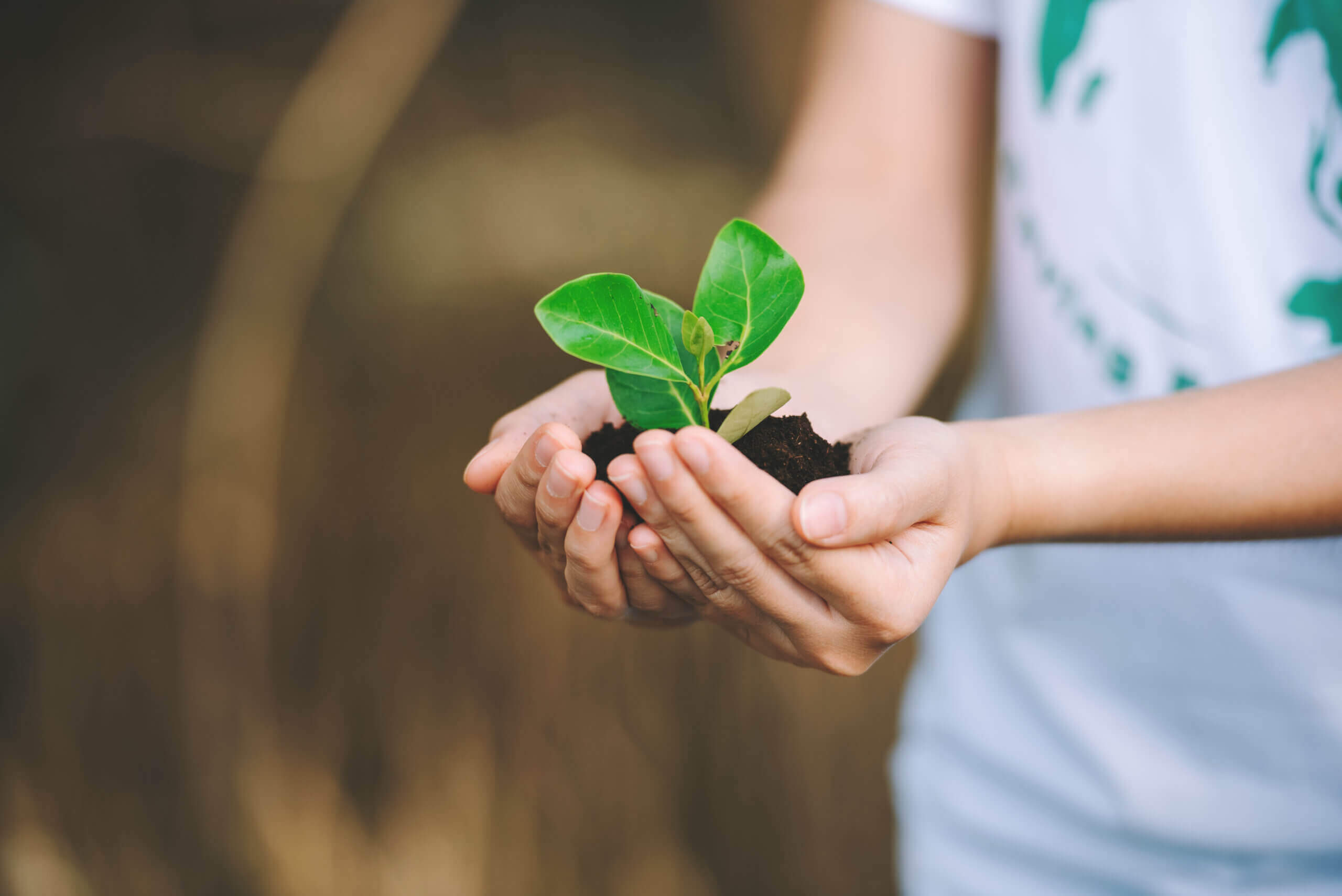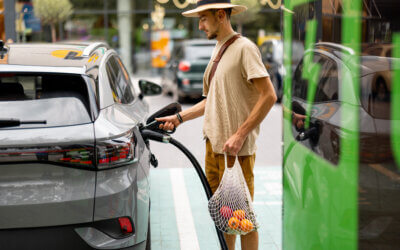Every year more than 600 billion disposable cups are thrown away or recycled around the world. [1] And by some estimates, 16 billion of those are disposable coffee cups. [2] From plastic and foam to everything in between, coffee cups are responsible for a substantial impact on the environment. If you’ve ever wondered how to reduce the carbon footprint of your morning cup of joe, then we are here to help. Below is everything you need to know about the environmental impact of coffee cups, some greener alternatives, and some practical ways you can help solve this growing problem.
What is the Carbon Footprint of Coffee Cups?
The carbon footprint of a coffee cup varies by material, manufacturing, and how many times it gets used before getting thrown out. According to Starbucks, each paper coffee cup has a footprint of about 0.24 pounds of CO2 emissions. [3] While that is not ideal, it may be better than some alternatives. According to one study commissioned by Huhtamaki, a global food packaging manufacturer, a paper cup may actually have the lowest carbon footprint compared to reusable plastic, steel, and ceramic cups. [4]
Hutamaki focused on several factors when estimating a cup’s footprint, including raw materials, manufacturing, and how it gets washed. When taking these factors into account, a ceramic cup would need to be used more than 350 times to have a smaller footprint than a recycled paper cup, and by the same estimates, a plastic cup would need to be used more than 36 times.[4]
Disposable Coffee Cups Environmental Impact
Disposable coffee cups have a wide-reaching effect on the environment. From production to disposal, the life-cycle of these cups is contributing to the world’s growing problems of waste, pollution, and climate change. Unfortunately for coffee lovers, the container is not the only problem. Disposable cups are part of a huge industry that continues to impact the environment in countless ways. Coffee is among the world’s most sought-after commodities, creating a $100 billion global industry. [5] Coffee often includes a carbon-heavy production cycle, from the farmers that grow it to the fuel it takes to transport it, every sip of coffee contains some hidden costs for the environment. And worse yet, if you don’t take your coffee black, the impact is even higher due to sugar and milk production.
What are Disposable Coffee Cups Made Of?
Single-use coffee cups come in a variety of materials, including foam, paper, and plastic. The most common type of containers used in coffee shops around the United States is a paper cup that includes a polyethylene (PE) coating to prevent the paper from soaking up the liquid inside of it. Every material offers different pros and cons for the environment. For example, PE coating on cups can be recycled but is not biodegradable. [6] Many popular coffee brands are still searching for improved materials to make their cups. Starbucks has even offered incentives such as a $10 million grant challenge to create a more recyclable cup. [7] Others, including Dunkin Donuts, have followed suit by pledging to eliminate foam cups from their stores. [8] While these steps mark significant progress, the best materials to use for a greener cup are still unclear.
Coffee Cups Waste Facts
While individuals, industry, and even governments work towards a more sustainable future for coffee cups, for now, they remain a significant problem. Below are some of the most shocking facts about coffee cup waste around the world:
- Every year, 20 million trees are cut down to make paper cups. [9]
- Paper cups in a landfill will take 20-30 years to break down. [10]
- 58 billion paper cups are thrown away in the U.S. annually. [11]
- 25 billion foam cups are used in the U.S. annually. [11]
- 99.75% of coffee cups are not recycled in the U.K. [12]
- 13 counties around the world have passed laws to ban single-use plastics, including cups in France. [13]
Ways to Reduce the Carbon Footprint of Your Coffee Cup
Reducing the carbon footprint of your coffee cup may take some effort and planning, but it is possible! Below we will explore some of the best ways to limit your impact, including alternative materials, popular multi-use cup options, and more ways you can continue to reduce, reuse, and recycle.
Alternative Sources
Remember that Starbucks cup challenge we mentioned earlier? Their efforts sparked some creative solutions to build a better cup. Their NextGen cup challenge received 480 entries and included some inventive ideas for greener cup materials, including: [14]
- Mushrooms
- Rice Husks
- Water Lily Pads
- Corn Leaves
- Artificial Spider Silk& More!
Sustainable Coffee Cups
While many of these sustainable alternatives have not reached the average consumer yet, there are some cups that almost anyone can start using today. However, it is crucial to keep in mind that to indeed be sustainable, these cups must be repeatedly used, washed in an eco-friendly way, and kept out of the landfill. Popular sustainable, multi-use coffee cups include:
- Ceramic
- Glass
- Stainless Steel
There are also more sustainable single-use materials for coffee cups that you can use at home or in the office, including:
- Paper cups made from recyclable materials
- Compostable cups
- Biodegradable cups
Starbucks: Reusable Coffee Cups
While the argument for switching to a reusable mug for your coffee is convincing, the majority of people are still sticking to their paper cups. There are many reasons why people are reluctant to switch. Traditional paper cups can be more convenient, and for some, the morning Starbucks cups are a status symbol. Luckily, reusable mugs come in many shapes and sizes, and many look precisely like their paper counterpart–Starbucks logo and all. Additionally, you may even save some money bringing in your own tumbler to your local coffee haunt, with many shops offering a discount for customers who bring in their own reusable cup.
Offsetting Your Coffee Cup Carbon Footprint
When it comes to coffee cups, it is impossible to reach zero. Almost every container and its contents will carry with it a measurable carbon footprint. However, there is a way to offset your morning coffee habit using carbon offsets from Terrapass. These third-party verified offsets help any person or business reduce or even eliminate their carbon emissions by supporting sustainable forestry, solar energy, and carbon capture projects. It all starts by measuring your daily impact. Check out our free carbon footprint calculator today to get started.
Brought to you by terrapass.com
Sources:
- Meyer, Zlati. “Starbucks Issues a $10M Challenge: Design a Compostable Coffee Cup.” USA Today, Gannett Satellite Information Network, 21 Mar. 2018, www.usatoday.com/story/money/2018/03/20/starbucks-wants-make-eco-friendly-coffee-cup/443504002/.
- “Fact Sheet: How Much Disposable Plastic We Use.” Earth Day, 21 Dec. 2019, www.earthday.org/fact-sheet-how-much-disposable-plastic-we-use/.
- Windsurfer, FlorianAs a passionate. “Eco-Friendly Coffee Cups (& Why Compostable Hot Cups Are Sustainable).” The Sustainable Citizen, 6 Oct. 2019, citizensustainable.com/coffee-cups/.
- “Life-Cycle Study Shows: a Paper Cup Has the Lowest Carbon Footprint – and Recycling Makes It Even Smaller.” Food Packaging, www.huhtamaki.com/en/media/media/press-release/2019/life-cycle-study-shows-a-paper-cup-has-the-lowest-carbon-footprint—and-recycling-makes-it-even-smaller/.
- Menke, Andrew. “The Global Coffee Industry.” GlobalEDGE Blog: The Global Coffee Industry >> GlobalEDGE: Your Source for Global Business Knowledge, GlobalEDGE, 19 Apr. 2018, globaledge.msu.edu/blog/post/55607/the-global-coffee-industry.
- “What’s the Difference Between PE & Waxed Paper Sheets?” Charlotte Packaging Ltd, 26 Sept. 2016, www.charlottepackaging.com/latest-news/whats-difference-pe-waxed-paper/.
- “Starbucks Offers $10 Million for Ideas on a Better Cup.” CNNMoney, Cable News Network, money.cnn.com/2018/03/21/news/companies/starbucks-cups/index.html.
- Ma, Adrian. “Dunkin’ Drops Foam Cups, Effectively Ending Practice Of ‘Double Cupping’.” NPR, NPR, 28 Nov. 2019, www.npr.org/2019/11/28/783622536/dunkin-drops-styrofoam-cups-effectively-ending-practice-of-double-cupping.
- Christian, Ashlee. “7 Staggering Facts about Your Coffee Cup.” Freelancers Union Blog, Freelancers Union Blog, 2 May 2014, blog.freelancersunion.org/2014/05/02/7-staggering-facts-about-your-coffee-cup/.
- “Pros and Cons of Paper Cups – Facts I Bet You Didn’t Know.” Eco Family Life, 28 Dec. 2018, ecofamilylife.com/eco-articles/pros-and-cons-of-paper-cups-facts-i-bet-you-didnt-know/.
- “The Disposable Cup Crisis.” Steely Drink Ware. https://steelysdrinkware.com/wp-content/uploads/2013/06/Cup_trash_infographic3.pdf.
- Team, Reality Check. “Plastic Recycling: Why Are 99.75% of Coffee Cups Not Recycled?” BBC News, BBC, 17 Apr. 2018, www.bbc.com/news/science-environment-43739043.
- 13 Countries That Have Banned Single-Use Plastics, www.msn.com/en-in/news/photos/13-countries-that-have-banned-single-use-plastics/ar-AAD1RAE.
- “Forget Plastic Straws. Starbucks Has a Cup Problem.” CNN, Cable News Network, www.cnn.com/interactive/2019/02/business/starbucks-cup-problem/index.html.







